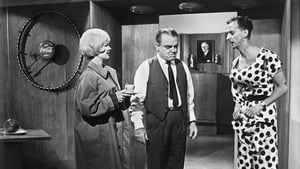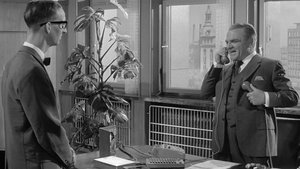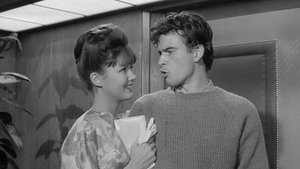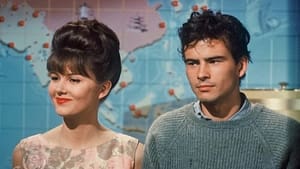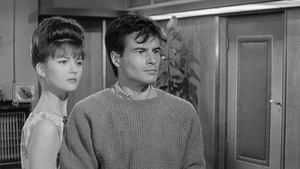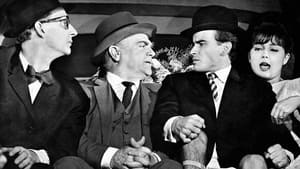Contact: info@alwanfilm.com
Video Sources 0 Views
- Watch trailer
- One Two Three 1961 Colorized


One Two Three 1961 Colorized
Synopsis
Table of Contents
ToggleReview: One Two Three 1961 Colorized – A Comedy Classic with a Sharp Political Edge

Introduction
Released in 1961, Billy Wilder’s “One, Two, Three” is a fast-paced, sharp-tongued satire set against the backdrop of Cold War tensions. Starring James Cagney in one of his most memorable roles, this comedy deftly blends political commentary with rapid-fire humor, delivering a biting critique of both American capitalism and Soviet communism. In this article, we will explore the enduring appeal of “One, Two, Three,” examining its performances, plot, and the impact of its satire on both contemporary audiences and film history.
Check The Full Colorized Movies List
Check Our Colorized Movies Trailer Channel
Understanding One Two Three 1961 Colorized: Director, Cast, and Genre
Billy Wilder, a legendary figure in Hollywood, is known for his ability to mix wit with biting social commentary. In “One, Two, Three,” Wilder took on the challenge of creating a comedy that was not only entertaining but also a reflection of the geopolitical landscape of the time. The film’s genre, a political satire wrapped in the guise of a screwball comedy, allowed Wilder to tackle serious issues while maintaining a light-hearted tone that resonated with audiences.
The casting of James Cagney as the lead, C.R. “Mac” MacNamara, was a stroke of genius. Known primarily for his tough-guy roles in gangster films, Cagney brought a unique energy to the role of a fast-talking, opportunistic Coca-Cola executive stationed in West Berlin. His performance is electric, showcasing his impeccable timing and ability to handle Wilder’s rapid dialogue with ease.
The supporting cast is equally impressive, featuring Horst Buchholz as Otto Piffl, a passionate East German communist, and Pamela Tiffin as Scarlett Hazeltine, the naive and impulsive daughter of MacNamara’s boss. Their performances, along with those of the ensemble cast, contribute to the film’s frenetic pace and comedic brilliance.
Exploring the World of One Two Three 1961 Colorized: Plot and Characters
Set in the divided city of Berlin during the height of the Cold War, “One, Two, Three” follows C.R. MacNamara, a Coca-Cola executive tasked with overseeing operations in West Berlin. MacNamara’s ambitions to rise within the company are put to the test when he is assigned the additional responsibility of looking after his boss’s daughter, Scarlett Hazeltine. Unbeknownst to him, Scarlett has fallen in love with Otto Piffl, a fervent East German communist, throwing MacNamara’s carefully controlled world into chaos.
The plot takes the audience on a whirlwind tour through the ideological battlegrounds of East and West Berlin, with MacNamara frantically trying to keep everything under control while navigating the complexities of Cold War politics. As he scrambles to turn Otto from a staunch communist into a suitable capitalist son-in-law, the film’s pace accelerates to a breathless speed, reflecting the manic energy of its protagonist.
The characters in “One, Two, Three” are sharply drawn, each representing different facets of the political and social landscape of the time. MacNamara embodies the relentless drive of American capitalism, constantly wheeling and dealing to achieve his goals. Scarlett represents the innocent but reckless youth of America, oblivious to the dangers of her actions. Otto, on the other hand, is the idealistic but naive communist, whose rigid beliefs are challenged by the seductive allure of Western consumerism.
The Art of Satire in One Two Three 1961 Colorized
Satire is at the heart of “One, Two, Three,” with Wilder using humor to expose the absurdities of both the capitalist and communist systems. The film is filled with clever wordplay, visual gags, and biting one-liners that poke fun at the ideological fervor of the Cold War era.
Wilder’s script, co-written with I.A.L. Diamond, is a masterclass in comedic timing and political satire. The rapid-fire dialogue is packed with double entendres and sharp jabs at both American and Soviet ideologies. The film’s humor often derives from the ridiculousness of the characters’ actions and the exaggerated situations they find themselves in, highlighting the absurdity of the geopolitical tensions that defined the era.
The Cold War as a Backdrop: Contextualizing One Two Three 1961 Colorized
The timing of “One, Two, Three” was crucial to its impact. Released in the early 1960s, the film came at a time when the Cold War was at its peak, with Berlin being a central point of conflict between East and West. The construction of the Berlin Wall in 1961, just a few months before the film’s release, added an extra layer of relevance to its storyline.
Wilder’s choice to set the film in Berlin was no accident. The city, divided into East and West, symbolized the broader ideological divide between capitalism and communism. By placing his characters in this volatile setting, Wilder was able to explore the tensions and contradictions of the Cold War through a comedic lens.
The Cultural Impact of One Two Three 1961 Colorized
Despite being a comedy, “One, Two, Three” had a significant impact on the way audiences perceived the Cold War. Wilder’s satirical approach allowed viewers to laugh at the absurdity of the political climate while also reflecting on the underlying issues. The film’s irreverence toward both American and Soviet ideologies resonated with audiences who were growing increasingly skeptical of the black-and-white narratives that dominated the era.
In the years following its release, “One, Two, Three” has been praised for its boldness in tackling such a sensitive subject with humor and intelligence. It has since become a cult classic, beloved for its wit, energy, and timeless commentary on the follies of ideological extremism.
The Fast-Paced Comedy Style: A Technical Marvel
One of the most remarkable aspects of “One, Two, Three” is its relentless pace. Wilder orchestrates the film like a symphony, with each scene building on the previous one, creating a crescendo of chaos by the film’s end. The editing is sharp, and the camera work, handled by Daniel L. Fapp, complements the rapid-fire dialogue, ensuring that the energy never lets up.
Cagney’s performance is central to this pace. His delivery is rapid and precise, capturing the urgency of MacNamara’s situation. The film’s physical comedy, from slapstick moments to exaggerated facial expressions, is executed with perfect timing, showcasing Cagney’s versatility as an actor.
The supporting cast plays off Cagney’s energy, contributing to the film’s fast-paced rhythm. Each actor’s timing is impeccable, creating a sense of controlled chaos that keeps the audience engaged from start to finish.
The Political and Social Commentary of One Two Three 1961 Colorized
Beyond its comedic surface, “One, Two, Three” offers pointed commentary on the political and social issues of the time. Wilder uses the film to satirize the superficiality and excesses of both American capitalism and Soviet communism, showing how both systems are flawed in their own ways.
MacNamara’s obsession with climbing the corporate ladder and securing a lucrative deal for Coca-Cola symbolizes the relentless pursuit of profit that defines American capitalism. His willingness to manipulate and exploit others to achieve his goals reflects the darker side of corporate ambition, where ethical considerations are often sacrificed for financial gain.
On the other hand, Otto’s rigid adherence to communist ideals is portrayed as naive and dogmatic. His eventual transformation, under MacNamara’s tutelage, into a model capitalist highlights the seductive power of consumerism and the ease with which ideological beliefs can be compromised for material comfort.
Wilder’s portrayal of these two systems is neither simplistic nor one-sided. Instead, he presents both capitalism and communism as equally absurd and flawed, using humor to expose the contradictions and hypocrisies inherent in each ideology.
Reception and Legacy of One Two Three 1961 Colorized
Upon its release, “One, Two, Three” received mixed reviews, with some critics praising its sharp wit and others criticizing its frenetic pace and heavy-handed satire. However, over time, the film has come to be recognized as a classic of political satire, with its humor and relevance enduring across generations.
James Cagney’s performance was universally lauded, with many considering it one of the finest of his career. The role of MacNamara allowed Cagney to showcase his range, moving effortlessly between comedic and dramatic moments. His ability to deliver Wilder’s rapid dialogue with such precision and energy is a testament to his talent and experience as an actor.
The film’s legacy is also evident in its influence on later political satires. “One, Two, Three” paved the way for films like Stanley Kubrick’s “Dr. Strangelove” and Armando Iannucci’s “The Death of Stalin,” which similarly use humor to critique political systems and the absurdity of ideological extremism.
The Challenges of Producing One Two Three 1961 Colorized
The production of “One, Two, Three” was not without its challenges. Filming in Berlin during the height of the Cold War added an element of unpredictability to the shoot. The construction of the Berlin Wall midway through production forced Wilder and his team to adapt quickly, with certain scenes having to be rewritten or relocated.
Additionally, the film’s rapid pace and complex dialogue required meticulous planning and rehearsal. Wilder’s attention to detail and insistence on perfect timing meant that the cast and crew had to work tirelessly to meet his high standards. Cagney, in particular, found the experience exhausting, and it is widely believed that the demanding nature of the role contributed to his decision to retire from acting shortly after the film’s release.
The Enduring Relevance of “One, Two, Three”
Even decades after its release, “One, Two, Three” remains a relevant and insightful film. The themes of ideological conflict, corporate greed, and the absurdity of political extremism are as pertinent today as they were in the 1960s. In a world still grappling with divisions and power struggles, Wilder’s satire continues to resonate, reminding us of the importance of humor and critical thinking in navigating complex issues.
The film’s rapid pace and sharp dialogue may feel overwhelming to some viewers, but it is precisely this energy that makes “One, Two, Three” a timeless classic. Wilder’s ability to blend humor with social commentary is unparalleled, and the film stands as a testament to his brilliance as a filmmaker.
Where to Watch One Two Three 1961 Colorized Online
For those interested in experiencing this comedic gem, “One, Two, Three” is available on various streaming platforms, including Amazon Prime Video, Google Play, and iTunes. Its availability ensures that new generations of viewers can appreciate Wilder’s sharp wit and Cagney’s unforgettable performance.
FAQs About One Two Three 1961 Colorized
Q: Is “One, Two, Three” based on a true story?
A: No, “One, Two, Three” is a fictional story, though it draws heavily on the real political tensions of the Cold War era. The film’s setting in Berlin and its depiction of the ideological conflict between capitalism and communism are grounded in the historical context of the time.
Q: Why did James Cagney retire after “One, Two, Three”?
A: While Cagney never explicitly cited “One, Two, Three” as the reason for his retirement, the film’s demanding production schedule and the intense nature of the role likely contributed to his decision. Cagney returned to acting only briefly in 1981 for “Ragtime.”
Q: What makes “One, Two, Three” a classic?
A: “One, Two, Three” is considered a classic due to its sharp wit, brilliant performances, and enduring relevance. Billy Wilder’s masterful direction and James Cagney’s electrifying performance make it a standout in the genre of political satire.
Conclusion
“One, Two, Three” is a film that masterfully blends comedy with sharp political commentary, offering a satirical look at the absurdities of both American capitalism and Soviet communism during the Cold War. Billy Wilder’s direction, combined with James Cagney’s standout performance, makes this film a timeless classic that continues to resonate with audiences today.
As we navigate the complexities of modern geopolitics, the lessons of “One, Two, Three” remain pertinent. The film reminds us that humor can be a powerful tool in confronting and understanding the absurdities of our world. Whether you’re a fan of classic cinema or new to the genre, “One, Two, Three” is a must-watch, offering both entertainment and insightful commentary that transcends its era.
